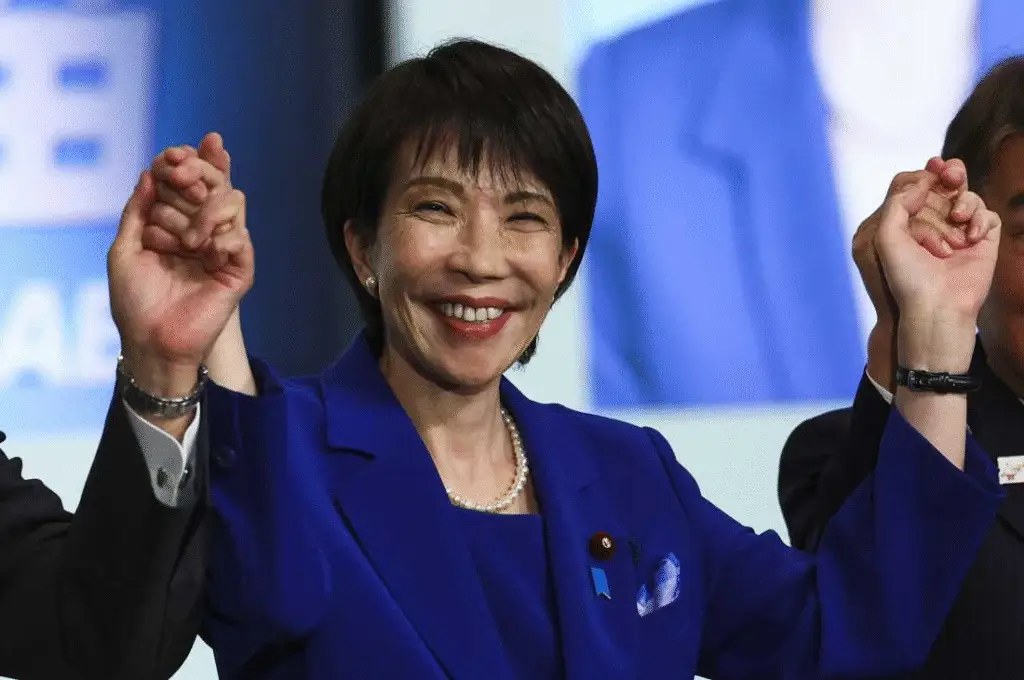Takaichi’s Rise to Power and Historic Achievement
Sanae Takaichi made history by becoming Japan’s first female prime minister after winning a poll that decided who would be the leader. Her selection is a big step forward for women’s representation in Japanese politics and a turning point in the country’s democratic development. After her victory, she visited with Emperor Naruhito, who formally made her Japan’s leader.
Takaichi was born in Nara Prefecture and started her political career in the 1990s. She worked her way up through the ranks of the Liberal Democratic Party. Many elite politicians went to excellent institutions overseas, but she came from a humble background. But her strong will and clear ideas made her one of the most important conservative voices in her party.

Source: NPR
Political Roots and Connection to Shinzo Abe’s Legacy
Takaichi’s political beliefs were influenced by her strong relationship with the late Prime Minister Shinzo Abe. During his time in office, she had many ministerial positions, which gave her expertise in crafting policies and running the government. Her support for “Abenomics,” which focuses on increasing government spending, making structural changes, and lowering interest rates to boost Japan’s economy, was inspired by Abe’s mentoring.
Her commitment to Abe’s conservative framework has made her look like a continuation of his leadership style. She now has to deal with the problems of a changing world while also reconciling her own political identity with the history she has inherited.
Japan’s “Iron Lady” and Her Conservative Stance
Takaichi is called Japan’s “Iron Lady” because she leads in a firm and uncompromising way, like Britain’s Margaret Thatcher. Her ideas include protecting the country, upholding traditional family values, and being careful when it comes to societal change.
She is against same-sex marriage and wants to keep the tradition of men being the first to inherit the throne. Her views on immigration are still conservative, and she wants to limit entrance to protect Japan’s cultural uniqueness. Conservative people agree with these beliefs, while younger progressives who want to modernize are not so sure.
Recommended Article: China and US Agree to Resume Trade Talks Amid Tariff Tensions
Takaichi’s Foreign Policy and Regional Strategy
Because of her strong position on foreign affairs, Takaichi has become known as a “China hawk.” She always pushes for Japan to enhance its military and stand firm in the Taiwan Strait. Her trips to see Taiwan’s political leaders showed that Japan was still behind its democratic partners in the area.
But her diplomatic past involves a lot of trouble over trips to Yasukuni Shrine, which commemorates war dead and convicted war criminals. China and South Korea have also criticized these visits, showing how hard it is for Takaichi to mix national pride with foreign diplomacy.
Domestic Challenges Awaiting Her Leadership
Japan’s economy is under more and more strain from rising prices, stagnant wages, and a shrinking population. Takaichi has to deal with these problems while also rebuilding public confidence after recent political scandals in the LDP.
She takes over a country that is having trouble because of growing living costs and the long-term impacts of global trade problems. To deal with these issues, she will have to prove that she can bring Japan’s divided political atmosphere back together and restore faith in her government.
Coalition Politics and Party Dynamics
The Liberal Democratic Party is still the most powerful party in Japan, although it has had problems with internal conflicts and unstable coalitions. Takaichi is in charge now that the LDP’s partnership with the far-right Sanseito party fell apart because of corruption and disagreements over money.
She made a fresh deal with the Japan Innovation Party to get a majority in parliament, which gave her some short-term stability. Experts, on the other hand, say that this alliance might break apart again if there are conflicts over policy goals during her time in office.
What Japan’s New Leader Needs to Do
Takaichi is Japan’s fourth prime minister in 5 years; thus, she has a lot of responsibility to run the country well. Global economic uncertainties, regional security threats, and public anger at political elites will all put her leadership to the test.
Analysts say that Takaichi has to soften her tough image if she wants to keep support from parliament and the people. If she can find a way to balance conservatism with pragmatism, she may be able to stay in power as a uniting national leader. If not, Japan’s unstable democracy may see another sudden political change.















